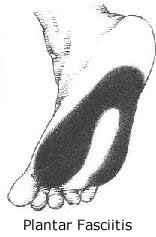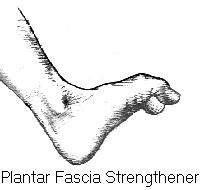Plantar Fasciitis
This is an inflammation of the plantar fascia, a thick, fibrous band of tissue in the bottom of the foot, running from the heel to the base of the toes. When placed under too much stress, the fascia stretches too far and tears, causing inflammation of the fascia and surrounding tissues. The tears are soon covered with scar tissue, which is less flexible than the fascia and only aggravates the problem.
 Symptoms: Pain at the base of the heel. “Most people describe it as feeling like a bone bruise or a stone bruise,” says Joe Ellis, D.P.M., a sports podiatrist from La Jolla, California, and the author of Running Injury-Free. “Plantar fasciitis is most severe in the morning when you get out of bed or at the beginning of a run, because the fascia is tighter at those times. The pain may fade as you walk or run.”
Symptoms: Pain at the base of the heel. “Most people describe it as feeling like a bone bruise or a stone bruise,” says Joe Ellis, D.P.M., a sports podiatrist from La Jolla, California, and the author of Running Injury-Free. “Plantar fasciitis is most severe in the morning when you get out of bed or at the beginning of a run, because the fascia is tighter at those times. The pain may fade as you walk or run.”
Often, a runner will change stride to alleviate pain, but this only provides temporary relief. A bone spur may also develop at the heel, where the fascia has started to tear away.
Causes: Stress, tension, and pulling on the plantar fascia. Runners with tight Achilles tendons (which put more stress on the fasciae), or high arches and rigid feet, or flat feed that overpronate are most susceptible. Worn-out shoes, which allow feet to overpronate, or shoes that are too stiff, which stretch the fasciae, can also make you more susceptible.
 Self-treatment: Reduce your running. Take aspirin or ibuprofen daily. Ice the area for 15 to 20 minutes several times a day.
Self-treatment: Reduce your running. Take aspirin or ibuprofen daily. Ice the area for 15 to 20 minutes several times a day.
Ice-massage the fascia. To do this, fill a paper cup with water and freeze. Peel off the paper, place the ice under your foot, and roll the foot over it, from your heel to the ball of your foot and back again. A frozen-juice can work equally well.
Medical treatment: If the injury hasn’t responded to self-treatment in four weeks, see a podiatrist, who may prescribe orthotics, ultrasound, or friction massage. Surgery to detach the fascia from its insertion into the heel may be recommended if medial treatments don’t help after a year. The success rate is 80 percent. Surgery to remove bone spurs usually doesn’t work. “The spur isn’t the problem,” says Dr. Ellis. “It’s a reaction to the problem.”
Alternative exercises: Swimming, pool running, and cycling in low gear. After surgery, only swimming is recommended during rehabilitation.
Preventive measures: Stretch your calf muscles. Strengthen muscles of the foot by picking up marbles or golf balls with your toes and pulling a towel toward you with your toes (Grab some of the towel with your toes and pull, then grab some more).
 To help stretch the fascia, you can perform a similar motion using a golf ball. Start with the golf ball under the base of your big toe and roll the foot forward over the ball to the base of the second toe and repeat. Do the same motion starting from each toe, always exerting enough pressure so that you can feel a little tenderness.
To help stretch the fascia, you can perform a similar motion using a golf ball. Start with the golf ball under the base of your big toe and roll the foot forward over the ball to the base of the second toe and repeat. Do the same motion starting from each toe, always exerting enough pressure so that you can feel a little tenderness.
Do the plantar fascia stretch: while sitting on the floor, with one knee bent and the same ankle flexed toward you, pull the toes back toward the ankle. Hold for a count of 10. Do 10 times.
Wear orthotics if you overpronate or have flat feet. Ice the area for 15 to 20 minutes after running. Run on soft surfaces. Don’t run in worn-out shoes. Incorporate more rest into your training schedule.
SOURCE:
Burffot, Anby, ed. Runners World Complete Book of Running. Rodale Press Inc., 1997.
